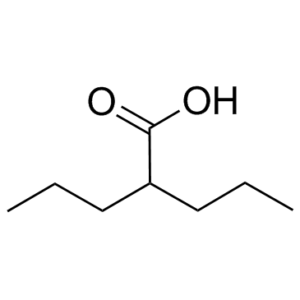Valproic acid
This product is for research use only, not for human use. We do not sell to patients.

For small sizes, please check our retail website as below: www.invivochem.com
| Size | Price | Stock |
|---|---|---|
| 5g | $100 | Check With Us |
| 10g | $160 | Check With Us |
| 20g | $240 | Check With Us |
Cat #: V3141 CAS #: 99-66-1; Purity ≥ 98%
Description: Valproic acid is an HDAC (Histone deacetylase) inhibitor used in the treatment of epilepsy, bipolar disorder and prevention of migraine headaches.
Top Publications Citing Invivochem Products
Publications Citing InvivoChem Products
Product Promise

- Physicochemical and Storage Information
- Protocol
- Related Biological Data
- Stock Solution Preparation
- Quality Control Documentation
| Molecular Weight (MW) | 144.21 |
|---|---|
| Molecular Formula | C8H16O2 |
| CAS No. | 99-66-1; |
| Storage | -20℃ for 3 years in powder formr |
| -80℃ for 2 years in solvent | |
| Solubility In Vitro | DMSO: ≥ 160 mg/mLr |
| Water:r | |
| Ethanol: | |
| SMILES Code | CCCC(CCC)C(O)=O |
| Synonyms | Valproic acid; Valproate |
| Protocol | In Vitro | Valproic acid (0-15 mM; 24 h) induces a G1 phase arrest at 1–3 mM and a G2/M phase arrest at 10 mM, and increases the percentage of sub-G1 cells in HeLa cells. Valproic acid also induces necrosis, apoptosis and lactate dehydrogenase (LDH) release. Valproic acid (10 mM; 24 h) significantly attenuates the activities of total, cytosol and nuclear HDACs. Valproic acid (VPA) (0-15 mM; 24 and 72 h) inhibits Hela cell growth in a dose- and time- dependent manner. |
|---|---|---|
| In Vivo | Valproic acid (VPA) (500 mg/kg; i.p.; daily for 12 days) inhibits tumor angiogenesis in mice transplanted with Kasumi-1 cells. |
These protocols are for reference only. InvivoChem does not
independently validate these methods.
| Solvent volume to be added | Mass (the weight of a compound) | |||
|---|---|---|---|---|
| Mother liquor concentration | 1mg | 5mg | 10mg | 20mg |
| 1mM | 6.9343 mL | 34.6717 mL | 69.3433 mL | 138.6866 mL |
| 5mM | 1.3869 mL | 6.9343 mL | 13.8687 mL | 27.7373 mL |
| 10mM | 0.6934 mL | 3.4672 mL | 6.9343 mL | 13.8687 mL |
| 20mM | 0.3467 mL | 1.7336 mL | 3.4672 mL | 6.9343 mL |
The molarity calculator equation
Mass(g) = Concentration(mol/L) × Volume(L) × Molecular Weight(g/mol)
Mass
=
Concentration
×
Volume
×
Molecular Weight*
The dilution calculator equation
Concentration(start)
×
Volume(start)
=
Concentration(final)
×
Volume(final)
This equation is commonly abbreviated as: C1 V1 = C2 V2
Concentration(start)
C1
×
Volume(start)
V1
=
Concentration(final)
C2
×
Volume(final)
V2
Step One: Enter information below
Dosage mg/kg
Average weight of animals g
Dosing volume per animal µL
Number of animals
Step Two: Enter the in vivo formulation
%DMSO
+
%
+
%Tween 80
+
%ddH2O
Calculation Results:
Working concentration:
mg/ml;
Method for preparing DMSO master liquid:
mg
drug pre-dissolved in
µL
DMSO(Master liquid concentration
mg/mL)
,Please contact us first if the concentration exceeds the DMSO solubility of the batch of drug.
Method for preparing in vivo formulation:
Take
µL
DMSO master liquid, next add
µL
PEG300, mix and clarify, next add
µL
Tween 80,mix and clarify, next add
µL
ddH2O,mix and clarify.
Note:
- (1) Please be sure that the solution is clear before the addition of next solvent. Dissolution methods like vortex, ultrasound or warming and heat may be used to aid dissolving.
- (2) Be sure to add the solvent(s) in order.




































